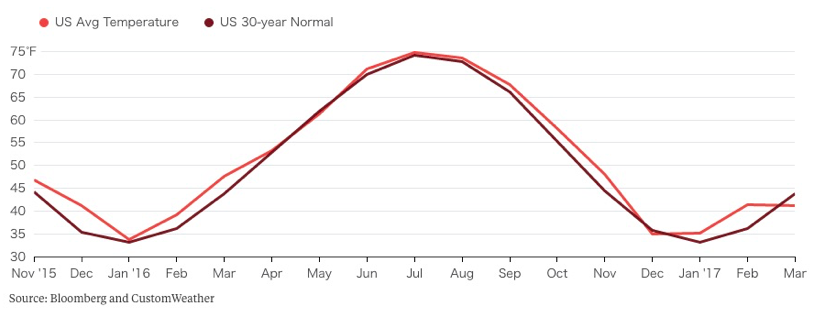
7 Common Retail Marketing Mistakes & How to Remedy Them
Pop quiz: What’s the number one thing retailers blame for slow shopping days?
If you said the weather, you’re right.
But guess what? As much as we all love to blame the weather for declining sales, it’s not the weather.
Just check out this graph that compares the average US temperature in 2016 to the average US temperature for the past 30 years. The differences are negligible — and certainly not enough to contribute to a widespread change in retail sales.

It’s Not the Weather, But It Might Be One of These Common Retail Marketing Mistakes
If we can’t blame the weather for declining sales, what can we blame? Perhaps one (or more) of these seven common retail marketing mistakes:
1) Poor Audience Segmentation
Today’s shoppers expect a personalized experience — there’s just no getting around it. And while there are varying levels of personalization, it all starts with proper audience segmentation.
For example, you might segment based on static factors like gender, basic dynamic factors like people who have purchased a certain product or category or advanced factors like predicted lifetime value, category affinity and discount preference. The more advanced you get along this scale, the more you can personalize your campaigns to deliver a message that hits home with your target audience.
Beyond not doing any audience segmentation, some of the most common mistakes that retailers make include:
- Not running advanced enough segmentation rules to build a targeted audience to which you can promote a specific message
- Making segmentation rules too narrow so that the resulting audience is too small to generate any significant revenue
- Matching the wrong message to each audience (note: getting segmentation right is only the first step, you also have to speak to those audiences the right way)
2) Not Being Prescriptive About the What, When & Where of Messages
In addition to audience segmentation, another important part of getting personalization right is being prescriptive about the what, when and where of your marketing messages.
Far too often, retailers send everything to everyone (hello, batch emails). While it’s true that you’ll likely never be able to remove batch and blast emails from your marketing program entirely, there’s a lot that you can do to both decrease your reliance on those batch emails and make the ones you do send more effective.
Specifically, you can try personalizing batch emails with dynamic product recommendations in order to be more prescriptive about what it is you send to each customer. Furthermore, you should take the time to understand different customers’ preferences in terms of timing and channel. Looking at channel choices, consider all of the channels on which you can reach your customers and evaluate factors like their likelihood to unsubscribe from emails in order to determine the best place to reach them.
3) A Lack of Lifecycle Marketing
Yet another piece of the personalization equation is customer lifecycle marketing. In this case, it’s about speaking to customers differently based on their stage in the buying cycle.
For instance, you should send customers who have indicated they are almost ready to make a purchase different messages than those who are still just exploring (in this scenario, you might send more or less targeted recommendations via triggered emails). On top of that, you should send entirely different messages to customers who are at-risk (perhaps a special offer to come back).
Unfortunately, many marketing teams miss out on the opportunity to have these targeted conversations with customers because they don’t have any way to measure and track where customers fall in the buying lifecycle or don’t use that knowledge to create unique campaigns for each group.
4) Static Lifecycle Marketing
Following closely on the heels of a lack of lifecycle marketing is ill-informed lifecycle marketing in which you don’t capture the correct lifecycle stage for customers. After all, how many of us have shaken our heads in wonder after receiving an email from a retailer to replenish an item we just purchased or after getting a “we miss you!” message shortly after visiting that same retailer’s website?
When this happens, we can usually blame static rules for lifecycle models, such as those that say all customers are at-risk after not making a purchase in 90 days. We all know this model is flawed, as some people make regular purchases far more frequently than 90 days while others make purchases far less frequently.
To remedy this challenge, try investing in more intelligent lifecycle models that use predictive recommendation technology to understand shopper behavior over time and develop individualized lifecycle models based on each customer’s unique purchase cadence.
5) Narrow Personalization Efforts
Many retailers hit all of the points above but go too narrow on their personalization efforts. This usually happens when it’s the marketers themselves driving the personalized recommendations.
When humans are behind the wheel, we see that someone bought a shirt and begin to recommend other shirts or perhaps even shorts to go with that shirt. But whatever the case, the recommendations are very narrow.
It’s a whole other story when you hand the reigns over to technology, which can cull large amounts of data and use predictive models to deliver much broader and smarter recommendations, for example by looking at category affinity predictions and common co-view behaviors from similar customers.
6) Emails Optimized for Design, Not Conversions
Most retailers have beautiful emails, but just because emails look beautiful, doesn’t mean they’re automatically effective. A beautiful brand lifestyle image might look appealing, but do your customers know where they’re going to land on your site when they click on that image? Usually not.
So what does it take to have beautiful emails that are also designed to drive conversions? While you don’t have to do away with lifestyle images, try adding in dynamic products in order to improve the structure and performance of your emails. These dynamic blocks should use rules to populate with products that are relevant to each customer, enticing them to click and making conversions more likely since customers know exactly where they’re going to land once they engage.
7) A Lack of Agility
Finally, one of the most common challenges retail marketing teams face is a lack of agility, both in terms of testing different strategies and tactics and being able to stand up new campaigns quickly.
In terms of testing, you should always test different elements of your marketing program in order to see what works and what doesn’t so that you can continuously improve your performance.
Meanwhile, too many retail marketing teams are unable to build and launch new campaigns quickly and on their own, which inhibits their ability to react to customers and events. But that type of agility can make a big difference. Just look at Steve Madden, whose marketing team was able to get a new campaign out the door in less than 24 hours (including creating the audience and building the email) after dancers in the Super Bowl halftime show wore one of their shoes. This agility allows the team to keep marketing timely and relevant and react to customers in real-time — something they have billed as a true game-changer.
What To Do Next: Make Your Top Retail Marketing Mistakes a Distant Memory
While the factors that contribute to declining sales are unique for every retailer, there are a handful of common retail marketing mistakes that often play a role. But one thing is for sure — it’s not the weather.
Once you identify any shortcomings in your marketing program, how can you right the ship? Take a look into how Hammacher Schlemmer’s marketing program has found success by engaging with customers in more relevant and timely ways and making data actionable.





